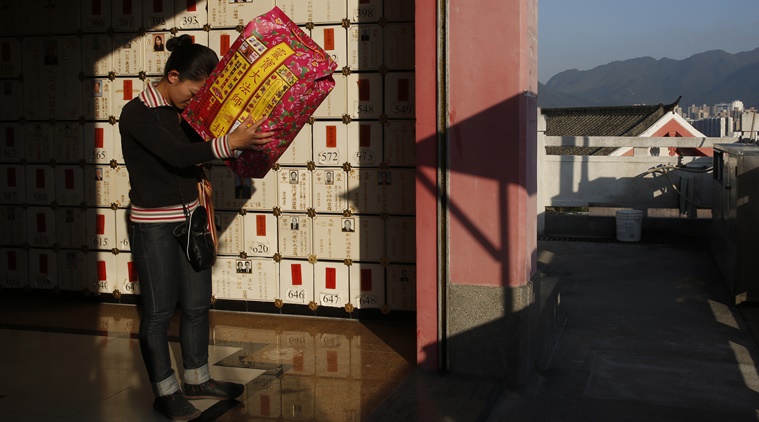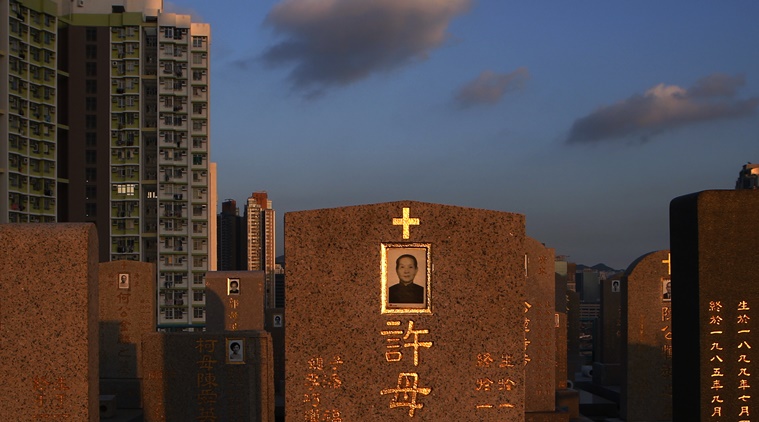After Chui Yuen-sing’s mother died in April, she was cremated and her ashes put in storage while he tried to find a final resting place. He was willing to wait up to 18 months for a pigeonhole-like ‘niche’ in a memorial building. If none was available, he was considering putting them in mainland China, where his father’s ashes are already stored, or taking an even more drastic step that conflicted with Chinese tradition.
“Maybe I would have scattered my mom’s ashes in a public park,” the retired university lecturer said. “But if I used this method then in my heart I probably wouldn’t feel very good,” he said. “Chinese people think that you should be buried in the ground to find peace.”
Chui’s choices highlight the long-running struggle to find enough space to accommodate both the living and the dead in the cramped southern Chinese city of 7.2 million. Limited land to build on and soaring property prices are colliding with a tradition of visiting grave sites on “tomb sweeping” holidays to burn incense and pay respects to venerated dead ancestors.
Hong Kong’s ageing society means the problem will get worse. The number of senior citizens is expected to rise from 15 per cent of the population in 2014 to nearly a quarter by 2024. The number of deaths each year will rise from 42,700 in 2010 to 50,300 by the end of the decade, according to government forecasts.
– See more at: http://indianexpress.com/article/lifestyle/life-style/in-crowded-hong-kong-dead-find-no-space-to-rest-in-peace/#sthash.djtpGwkU.dpuf

A woman prays as she holds a package of paper money intended to be burned as offerings to her dead father with a wall of niches for cremated remains in the background at a private columbarium in Hong Kong. (Source: AP)
In the 1960s, administrators of Hong Kong, which was then a British colony, began encouraging cremation to ease the strain of a fast-growing population on space-starved cemeteries. Now, the cremation rate has risen to about 90 per cent. To store the ashes, the government builds large structures known as columbariums that have tens of thousands of niches for urns as well as furnaces to burn paper money and other offerings. But supply hasn’t kept up with demand. “There’s undoubtedly not enough,” said Lam Wai-lung, chairman of the Funeral Business Association. Official attempts to encourage local councils to build more face fierce opposition, he said.
Also see | PHOTOS: In Hong Kong, there is no space for the dead
“When the government holds consultations, residents of every district oppose building it in their neighborhood. Every area says no,” Lam said. Part of the reason is that columbaria draw huge crowds of people during tomb sweeping holidays, causing big traffic jams and air pollution from the paper offerings being burned.
Families face a waiting list of up to six years for a government-provided niche, so some turn to private providers, including more than 120 that have been deemed illegal. But private niches can be too expensive for many families, with prices at one temple ranging from 73,000 Hong Kong dollars ($9,500) to HK$890,000 ($115,000).
– See more at: http://indianexpress.com/article/lifestyle/life-style/in-crowded-hong-kong-dead-find-no-space-to-rest-in-peace/#sthash.djtpGwkU.dpuf

Graves are placed next to apartment buildings at a cemetery in the Kowloon City district of Hong Kong. (Source: AP)
Since 2007, authorities have also been promoting “green” burials by scattering ashes at sea or in 11 gardens of remembrance. But such practices conflict with Chinese traditions that hold that burying remains in an auspicious spot on a mountainside or near the sea are vital for a family’s fortunes.
The government has been trying to change attitudes with educational videos and seminars at retirement homes. It’s even set up an electronic memorial website where families can post photos and videos of the deceased and send electronic offerings of plums or roast pork. Interest remains limited, with green burials rising from a few dozen in 2005 to only 3,553 last year.
Some companies are offering more creative solutions
Sage Funeral Services started offering a service three years ago through a South Korean laboratory that uses ultrahigh heat to turn ashes into memorial gems.
“In the first year everybody said I’m crazy,” said Betsy Ma, Sage’s sales director, who had her father’s ashes made into gems that she wears in her earrings and necklace. Many Chinese believe that carrying human remains as jewellery or storing them at home will attract ghosts, said Ma. Still, in the past year the procedure has gained in popularity, she said.
– See more at: http://indianexpress.com/article/lifestyle/life-style/in-crowded-hong-kong-dead-find-no-space-to-rest-in-peace/#sthash.djtpGwkU.dpuf
[Source:-.The.Indian.Express]
